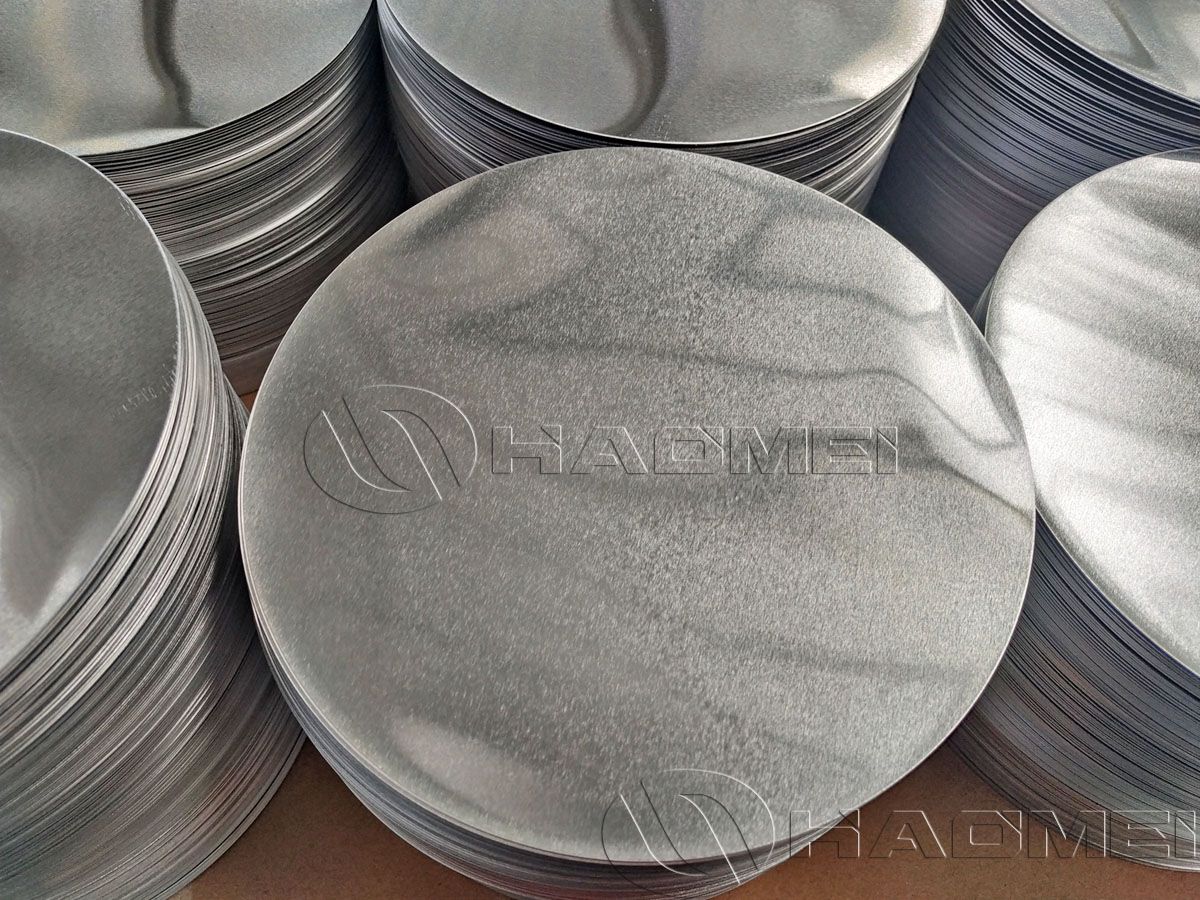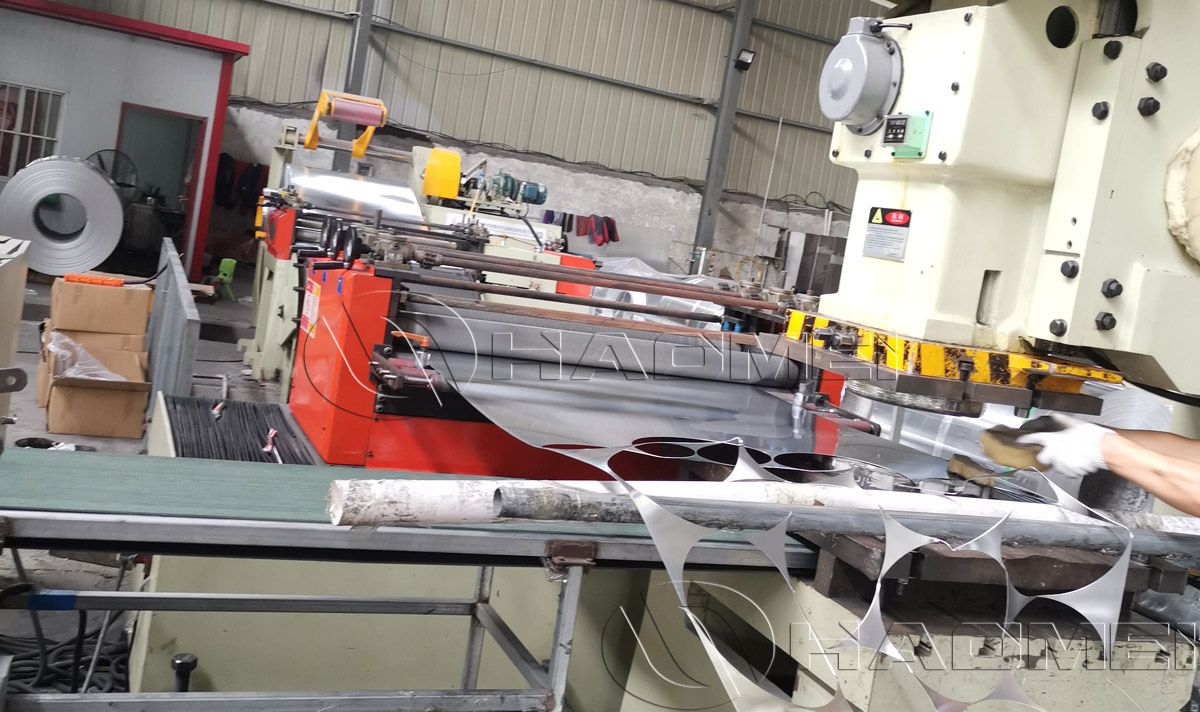
 No.14 Waihuan Road, CBD, Zhengzhou, China
No.14 Waihuan Road, CBD, Zhengzhou, China
 +86-18703635966
+86-18703635966

 No.14 Waihuan Road, CBD, Zhengzhou, China
No.14 Waihuan Road, CBD, Zhengzhou, China
 +86-18703635966
+86-18703635966
Aluminum sheet is the raw material for producing aluminum circles, obtained through extrusion and rolling to achieve the required thickness and shape. Haomei Aluminum manufactures aluminum circles from 1xxx, 3xxx, 4xxx, 5xxx, and 8xxx series alloys, widely used in cookware, construction, aerospace, automotive, electronics, and many other industries.
The 1050 aluminum circle is made by stamping, cutting, or laser processing aluminum coils or sheets into round flat blanks. Among all alloys, 1050 aluminum wafers are one of the most widely used products due to their high purity, excellent ductility, and cost-effectiveness. After anodizing and coloring, they show excellent surface stability with minimal discoloration.
Two common production methods for 1050 aluminum circle discs are hot rolling and cold rolling, and the choice determines the circle’s performance, appearance, and application direction.

DC (Direct Chill Casting) and CC (Continuous Casting) are the two primary manufacturing processes for producing 1050 aluminum circles.
Belongs to hot rolling. Aluminum is first cast into large ingots and then rolled at high temperature into sheets.
Deep Drawing: DC aluminum circles are ideal for deep drawing applications such as deep pots, frying pans, or complex cookware. The microstructure is more uniform, reducing cracking and ensuring better stretchability.
Surface Quality: DC material generally has a smoother surface with more uniform anodizing results.
Cost: The process is more complex, so DC material usually costs more than CC material.
Belongs to cold rolling. Molten aluminum is directly cast and rolled into thin strips.
Deep Drawing: CC aluminum circles have weaker deep drawing performance and are less suitable for heavy stretching.
Cost: More streamlined production process, lower cost, and more economical.
Application: CC aluminum is typically used for products with lower forming requirements, such as shallow pans, pot lids, or items formed by simple stamping or spinning.

If your products require high surface quality, precision dimensions, or deep drawing (e.g., premium cookware, precision electronics, decorative nameplates), DC (Direct Chill Casting) is the better option.
If your application involves further rolling or focuses more on cost-efficiency with lower surface requirements, CC (Continuous Casting) material is more economical.
| Temper | O, H12, H14, H18, etc. |
| Diameter | 100 mm - 1200 mm (customizable) |
| Thickness | 0.3 mm - 6.0 mm |
| Tolerance | Diameter ±0.1 mm, thickness ±0.01 mm (per customer requirements) |
| Surface Treatment | Brushed, polished, anodized, painted |
| Samples | Available |
| Applications | Cookware, lighting, traffic signs, heat sinks, etc. |
| MOQ | 1-3 tons |
1050 Pure Aluminum Disc Chemical Composition (%)
Aluminum (Al): ≥ 99.5%
Silicon (Si): ≤ 0.25%
Copper (Cu): ≤ 0.05%
Iron (Fe): ≤ 0.40%
Manganese (Mn): ≤ 0.05%
Magnesium (Mg): ≤ 0.05%
Other impurities: ≤ 0.03%
Mechanical Properties of 1050 Aluminum Circles (Typical O Temper)
Tensile strength: 60-100 MPa
Yield strength: 15-30 MPa
Elongation: ≥ 25%
Physical Properties of 1050 Aluminum Circle
Density: 2.71 g/cm³
Electrical conductivity: ~61% IACS
Thermal conductivity: ~237 W/m·K
Melting point: 660 ℃
Reflectivity: up to 80% (polished >85%)
High Purity & Stable Performance: Excellent corrosion resistance and chemical stability, suitable for food-grade and pharmaceutical-grade contact.
Outstanding Formability: Excellent deep drawing, spinning, and stretching performance, widely used for complex cookware and lighting products.
Excellent Surface Adaptability: Suitable for polishing, anodizing, electrophoresis, and coating for enhanced decorative and protective properties.
Green & Sustainable: Fully recyclable, aligned with sustainable development requirements.
Economical & Practical: Lower cost compared with 3xxx and 5xxx alloys, offering great value in large-scale applications.

Cookware Industry: Pots, bowls, pans, etc. Excellent deep drawing and spinning properties meet cookware forming needs.
Lighting Industry: Lamp covers, lamp bases, etc. High reflectivity and gloss improve lighting efficiency and appearance.
Transportation: Traffic signs, automotive parts, etc. Excellent corrosion resistance and workability for outdoor use.
Building Decoration: Curtain walls, ceilings, and decorative panels. Anodizing allows diverse colors and surface effects.
Electronics Industry: Electronic components, battery tabs, etc. Good electrical conductivity makes it advantageous in electronics.
Temper Selection: Choose according to forming needs. O temper is soft with good ductility for deep drawing; H18 is harder with higher strength but lower formability.
Specification Parameters: Provide accurate thickness (with tolerance) and diameter requirements to the supplier.
Surface Quality: Ensure no scratches, bubbles, or oil stains to avoid issues in polishing or coating.
Surface Treatment Needs: Decide if anodizing, coating, or polishing is required for your product.
Certification & Standards: Prefer suppliers with ISO, RoHS, SGS, FDA certifications to ensure compliance with food-grade and environmental standards.
Copyright © 2025 By HAOMEI Aluminum CO., LTD. All Rights Reserved. Sitemap